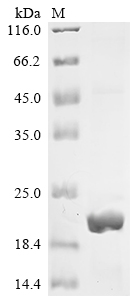Recombinant Human C-Jun-amino-terminal kinase-interacting protein 4 (SPAG9) , partial
CAT:
399-CSB-EP022470HU-02
Size:
100 µg
Price:
Ask
- Availability: 24/48H Stock Items & 2 to 6 Weeks non Stock Items.
- Dry Ice Shipment: No




Recombinant Human C-Jun-amino-terminal kinase-interacting protein 4 (SPAG9) , partial
- CAS Number: 9000-83-3
- Gene Name: SPAG9
- UniProt: O60271
- Expression Region: 408-534aa
- Organism: Homo sapiens
- Target Sequence: REVENLILENTQLLETKNALNIVKNDLIAKVDELTCEKDVLQGELEAVKQAKLKLEEKNRELEEELRKARAEAEDARQKAKDDDDSDIPTAQRKRFTRVEMARVLMERNQYKERLMELQEAVRWTEM
- Tag: N-terminal 10xHis-tagged and C-terminal Myc-tagged
- Source: E.coli
- Field of Research: Developmental Biology
- Assay Type: In Stock Protein
- Relevance: The JNK-interacting protein (JIP) group of scaffold proteins selectively mediates JNK signaling by aggregating specific components of the MAPK cascade to form a functional JNK signaling module. Regulates lysosomal positioning by acting as an adapter protein which links PIP4P1-positive lysosomes to the dynein-dynactin complex. Assists PIKFYVE selective functionality in microtubule-based endosome-to-TGN trafficking.
- Purity: Greater than 85% as determined by SDS-PAGE.
- Activity: Not Test
- Length: Partial
- Form: Liquid or Lyophilized powder
- Buffer: If the delivery form is liquid, the default storage buffer is Tris/PBS-based buffer, 5%-50% glycerol. If the delivery form is lyophilized powder, the buffer before lyophilization is Tris/PBS-based buffer, 6% Trehalose, pH 8.0.
- Reconstitution: We recommend that this vial be briefly centrifuged prior to opening to bring the contents to the bottom. Please reconstitute protein in deionized sterile water to a concentration of 0.1-1.0 mg/mL.We recommend to add 5-50% of glycerol (final concentration) and aliquot for long-term storage at -20℃/-80℃. Our default final concentration of glycerol is 50%. Customers could use it as reference.
- Molecular Weight: 20.0 kDa
- References & Citations: "Robust phosphoproteomic profiling of tyrosine phosphorylation sites from human T cells using immobilized metal affinity chromatography and tandem mass spectrometry." Brill L.M., Salomon A.R., Ficarro S.B., Mukherji M., Stettler-Gill M., Peters E.C. Anal. Chem. 76:2763-2772 (2004)
- Storage Conditions: The shelf life is related to many factors, storage state, buffer ingredients, storage temperature and the stability of the protein itself. Generally, the shelf life of liquid form is 6 months at -20℃/-80℃. The shelf life of lyophilized form is 12 months at -20℃/-80℃.
